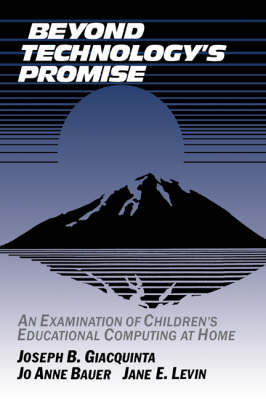
Beyond Technology's Promise
An Examination of Children's Educational Computing at Home
Seiten
1994
Cambridge University Press (Verlag)
978-0-521-40784-7 (ISBN)
Cambridge University Press (Verlag)
978-0-521-40784-7 (ISBN)
After taking a hard look at the computer scene in a three year investigation and drawing the not surprising conclusion that most children use computers to play games, this text, first published in 1994, proposes directions to be taken to facilitate the educational use of computers and other promising technology.
As personal computers have become more available, there has been a great deal of optimism for educational reform through wide computer use, both at school and in the home. Beyond Technology's Promise, first published in 1994, takes a hard look at the home computer scene. The research reported in the book focuses on whether families are using computers to help children learn academic skills and, if so, how well they are doing it. The three year, qualitative investigation provides contextual information crucial to our understanding of how computers are really being used. The authors draw the not so surprising conclusion that most children use computers to play games. They therefore propose directions that must be taken in order to facilitate the educational use of home computers or any other promising educational technology. In so doing, they examine such topics as parental leadership, the home-school computer connection, and the role of gender in home computing use.
As personal computers have become more available, there has been a great deal of optimism for educational reform through wide computer use, both at school and in the home. Beyond Technology's Promise, first published in 1994, takes a hard look at the home computer scene. The research reported in the book focuses on whether families are using computers to help children learn academic skills and, if so, how well they are doing it. The three year, qualitative investigation provides contextual information crucial to our understanding of how computers are really being used. The authors draw the not so surprising conclusion that most children use computers to play games. They therefore propose directions that must be taken in order to facilitate the educational use of home computers or any other promising educational technology. In so doing, they examine such topics as parental leadership, the home-school computer connection, and the role of gender in home computing use.
List of tables and figures; Preface; 1. The promise; 2. Studying the promise; 3. The absence of children's academic computering at home; 4. The availability of educational software; 5. The importance of parental encouragement and assistance; 6. The role of gender in home computer use; 7. School use of computers; 8. Children's preference for games; 9. Refining a new technology as a social innovation; 10. Viewing technology change as a social process; 11. Re-examining the home-school computer connection; 12. Where do we go from here?; Appendices; References; Index.
| Erscheint lt. Verlag | 28.1.1994 |
|---|---|
| Zusatzinfo | Worked examples or Exercises |
| Verlagsort | Cambridge |
| Sprache | englisch |
| Maße | 156 x 234 mm |
| Gewicht | 380 g |
| Themenwelt | Schulbuch / Wörterbuch ► Unterrichtsvorbereitung ► Unterrichts-Handreichungen |
| Informatik ► Software Entwicklung ► User Interfaces (HCI) | |
| Sozialwissenschaften ► Pädagogik | |
| ISBN-10 | 0-521-40784-2 / 0521407842 |
| ISBN-13 | 978-0-521-40784-7 / 9780521407847 |
| Zustand | Neuware |
| Haben Sie eine Frage zum Produkt? |
Mehr entdecken
aus dem Bereich
aus dem Bereich
Aus- und Weiterbildung nach iSAQB-Standard zum Certified Professional …
Buch | Hardcover (2023)
dpunkt Verlag
CHF 48,85
Lean UX und Design Thinking: Teambasierte Entwicklung …
Buch | Hardcover (2022)
dpunkt (Verlag)
CHF 48,85
Wissensverarbeitung - Neuronale Netze
Buch | Hardcover (2023)
Carl Hanser (Verlag)
CHF 48,95


